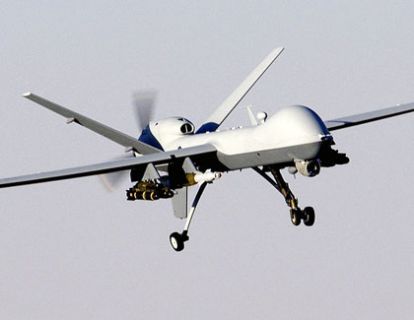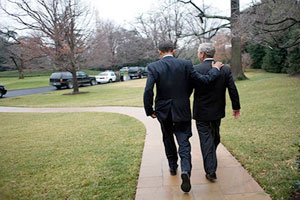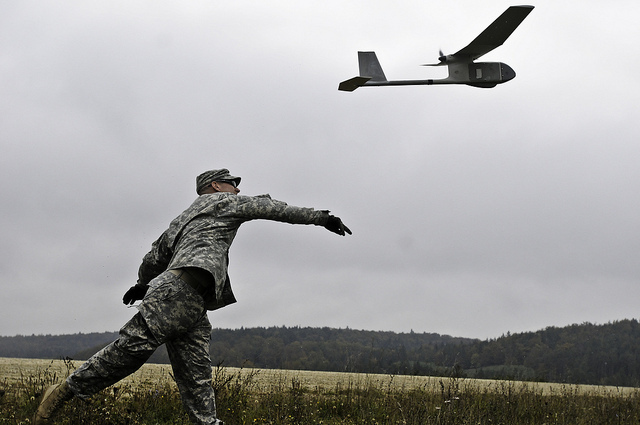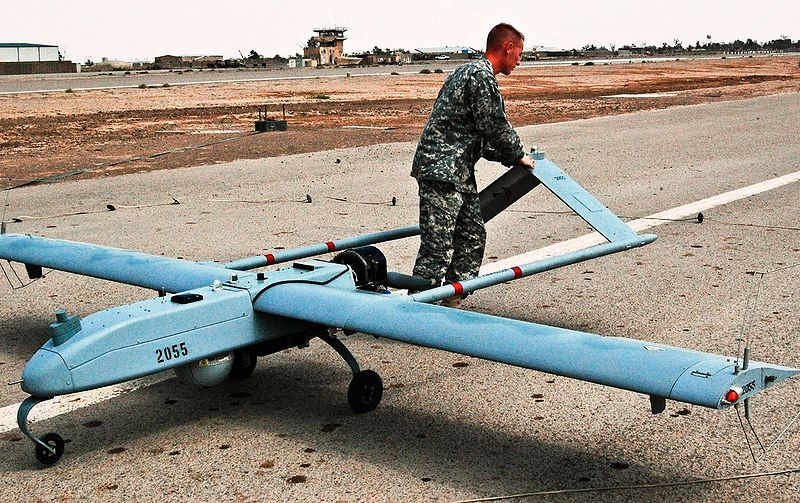
MQ-9 Reaper in flight.<a href="http://www.af.mil/shared/media/photodb/photos/071127-F-2185F-105.jpg">Staff Sgt. Brian Ferguson</a>/US Air Force photo
![]() This story first appeared on the TomDispatch website.
This story first appeared on the TomDispatch website.
When men first made war in the air, the imagery that accompanied them was of knights jousting in the sky. Just check out movies like Wings, which won the first Oscar for Best Picture in 1927 (or any Peanuts cartoon in which Snoopy takes on the Red Baron in a literal “dogfight”). As late as 1986, five years after two American F-14s shot down two Soviet jets flown by Libyan pilots over the Mediterranean’s Gulf of Sidra, it was still possible to make the movie Top Gun. In it, Tom Cruise played “Maverick,” a US Naval aviator triumphantly involved in a similar incident. (He shoots down three MiGs.)
Admittedly, by then American air-power films had long been in decline. In Vietnam, the US had used its air superiority to devastating effect, bombing the north and blasting the south, but go to American Vietnam films and, while that US patrol walks endlessly into a South Vietnamese village with mayhem to come, the air is largely devoid of planes.
Consider Top Gun an anomaly. Anyway, it’s been 25 years since that film topped the box-office—and don’t hold your breath for a repeat at your local multiplex. After all, there’s nothing left to base such a film on.
To put it simply, it’s time for Americans to take the “war” out of “air war.” These days, we need a new set of terms to explain what US air power actually does.
Start this way: American “air superiority” in any war the US now fights is total. In fact, the last time American jets met enemy planes of any sort in any skies was in the First Gulf War in 1991, and since Saddam Hussein’s once powerful air force didn’t offer much opposition—most of its planes fled to Iran—that was brief. The last time US pilots faced anything like a serious challenge in the skies was in North Vietnam in the early 1970s. Before that, you have to go back to the Korean War in the early 1950s.
This, in fact, is something American military types take great pride in. Addressing the cadets of the Air Force Academy in early March, for example, Secretary of Defense Robert Gates stated: “There hasn’t been a US Air Force airplane lost in air combat in nearly 40 years, or an American soldier attacked by enemy aircraft since Korea.”
And he’s probably right, though it’s also possible that the last American plane shot down in aerial combat was US Navy pilot Michael Scott Speiker’s jet in the First Gulf War. (The Navy continues to claim that the plane was felled by a surface-to-air missile.) As an F-117A Stealth fighter was downed by a surface-to-air missile over Serbia in 1999, it’s been more than 11 years since such a plane was lost due to anything but mechanical malfunction. Yet in those years, the US has remained almost continuously at war somewhere and has used air power extensively, as in its “shock and awe” launch to the invasion of Iraq, which was meant to “decapitate” Saddam Hussein and the rest of the Iraqi leadership. (No plane was lost, nor was an Iraqi leader of any sort taken out in those 50 decapitation attacks, but “dozens” of Iraqi civilians died.) You might even say that air power, now ramping up again in Afghanistan, has continued to be the American way of war.
From a military point of view, this is something worth bragging about. It’s just that the obvious conclusions are never drawn from it.
The Valor of Pilots
Let’s begin with this: to be a “Top Gun” in the US military today is to be in staggeringly less danger than any American who gets into a car and heads just about anywhere, given this country’s annual toll of about 34,000 fatal car crashes. In addition, there is far less difference than you might imagine between piloting a drone aircraft from a base thousands of miles away and being inside the cockpit of a fighter jet.
Articles are now regularly written about drone aircraft “piloted” by teams sitting at consoles in places like Creech Air Force Base in Nevada. Meanwhile, their planes are loosing Hellfire missiles thousands of miles away in Afghanistan (or, in the case of CIA “pilots,” in the Pakistani tribal borderlands). Such news accounts often focus on the eerie safety of those pilots in “wartime” and their strange detachment from the actual dangers of war—as, for instance, in the sign those leaving Creech pass that warns them to “drive carefully” as this is “the most dangerous part of your day.”
When it comes to pilots in planes flying over Afghanistan, we imagine something quite different—and yet we shouldn’t. Based on the record, those pilots might as well be in Nevada, since there is no enemy that can touch them. They are inviolate unless their own machines betray them and, with the rarest of imaginable exceptions, will remain so.
Nor does anyone here consider it an irony that the worst charge lodged by US military spokespeople against their guerrilla enemies, whose recruits obviously can’t take to the skies, is that they use “human shields” as a defense. This transgression against “the law of war” is typical of any outgunned guerrilla force which, in Mao Zedong’s dictum, sees immense benefit in “swimming” in a “sea” of civilians. (If they didn’t do so and fought like members of a regular army, they would, of course, be slaughtered.)
This is considered, however implicitly, a sign of ultimate cowardice. On the other hand, while a drone pilot cannot (yet) get a combat award citation for “valor,” a jet fighter pilot can and no one—here at least—sees anything strange or cowardly about a form of warfare which guarantees the American side quite literal, godlike invulnerability.
War by its nature is often asymmetrical, as in Libya today, and sometimes hideously one-sided. The retreat that turns into a rout that turns into a slaughter is a relative commonplace of battle. But it cannot be war, as anyone has ever understood the word, if one side is never in danger. And yet that is American air war as it has developed since World War II.
It’s a long path from knightly aerial jousting to air war as… well, what? We have no language for it, because accurate labels would prove deflating, pejorative, and exceedingly uncomfortable. You would perhaps need to speak of cadets at the Air Force Academy being prepared for “air slaughter” or “air assassination,” depending on the circumstances.
From those cadets to Secretary of Defense Gates to reporters covering our wars, no one here is likely to accept the taking of “war” out of air war. And because of that, it is—conveniently—almost impossible for Americans to imagine how American-style war must seem to those in the lands where we fight.
Apologies All Around
Consider for a moment one form of war-related naming where our language changes all the time. That’s the naming of our new generations of weaponry. In the case of those drones, the two main ones in US battle zones at the moment are the Predator (as in the sci-fi film) and the Reaper (as in Grim). In both cases, the names imply an urge for slaughter and a sense of superiority verging on immortality.
And yet we don’t take such names seriously. Though we’ve seen the movies (and most Afghans haven’t), we don’t imagine our form of warfare as like that of the Predator, that alien hunter of human prey, or a Terminator, that machine version of the same. If we did, we would have quite a different picture of ourselves, which would mean quite a different way of thinking about how we make war.
From the point of view of Afghans, Pakistanis, or other potential target peoples, those drones buzzing in the sky must seem very much like real-life versions of Predators or Terminators. They must, that is, seem alien and implacable like so many malign gods. After all, the weaponry from those planes is loosed without recourse; no one on the ground can do a thing to prevent it and little to defend themselves; and often enough the missiles and bombs kill the innocent along with those our warriors consider the guilty.
 Take a recent event on a distant hillside in Afghanistan’s Kunar Province where 10 boys, including two sets of brothers, were collecting wood for their families on a winter’s day when the predators—this time American helicopters evidently looking for insurgents who had rocketed a nearby American base—arrived. Only one of the boys survived (with wounds) and he evidently described the experience as one of being “hunted”—as the Predator hunts humans or human hunters stalk animals. They “hovered over us,” he said, “scanned us, and we saw a green flash,” then the helicopters rose and began firing.
Take a recent event on a distant hillside in Afghanistan’s Kunar Province where 10 boys, including two sets of brothers, were collecting wood for their families on a winter’s day when the predators—this time American helicopters evidently looking for insurgents who had rocketed a nearby American base—arrived. Only one of the boys survived (with wounds) and he evidently described the experience as one of being “hunted”—as the Predator hunts humans or human hunters stalk animals. They “hovered over us,” he said, “scanned us, and we saw a green flash,” then the helicopters rose and began firing.
For this particular nightmare, war commander General David Petraeus apologized directly to Afghan President Hamid Karzai, who has for years fruitlessly denounced US and NATO air operations that have killed Afghan civilians. When an angered Karzai refused to accept his apology, Secretary of Defense Gates, on a surprise visit to the country, apologized as well, as did President Obama. And that was that—for the Americans.
Forget for a moment what this incident tells us about a form of warfare in which helicopter pilots, reasonably close to the ground (and modestly more vulnerable than pilots in planes), can’t tell boys with sticks from insurgents with guns. The crucial thing to keep in mind is that, no matter how many apologies may be offered afterwards, this can’t stop. According to the Wall Street Journal, death by helicopter is, in fact, on the rise. It’s in the nature of this kind of warfare. In fact, Afghan civilians have repeatedly, even repetitiously, been blown away from the air, with or without apologies, since 2001. Over these years, Afghan participants at wedding parties, funerals, and other rites have, for example, been wiped out with relative regularity, only sometimes with apologies to follow.
In the weeks that preceded the killing of those boys, for instance, a “NATO”—these are usually American—air attack took out four Afghan security guards protecting the work of a road construction firm and wounded a fifth, according to the police chief of Helmand Province; a similar “deeply regrettable incident” took out an Afghan army soldier, his wife, and his four children in Nangarhar Province; and a third, also in Kunar Province, wiped out 65 civilians, including women and children, according to Afghan government officials. Karzai recently visited a hospital and wept as he held a child wounded in the attack whose leg had been amputated.
The US military did not weep. Instead, it rejected this claim of civilian deaths, insisting as it often does that the dead were “insurgents.” It is now—and this is typical—”investigating” the incident. General Petraeus managed to further offend Afghan officials when he visited the presidential palace in Kabul and reportedly claimed that some of the wounded children might have suffered burns not in an air attack but from their parents as punishment for bad behavior and were being counted in the casualty figures only to make them look worse.
Over the years, Afghan civilian casualties from the air have waxed and waned, depending on how much air power American commanders were willing to call in, but they have never ceased. As history tells us, air power and civilian deaths are inextricably bound together. They can’t be separated, no matter how much anyone talks about “surgical” strikes and precision bombing. It’s simply the barbaric essence, the very nature of this kind of war, to kill noncombatants.
One question sometimes raised about such casualties in Afghanistan is this: according to U.N. statistics, the Taliban (via roadside bombs and suicide bombers) kills far more civilians, including women and children, than do NATO forces, so why do the US-caused deaths stick so in Afghan craws when we periodically investigate, apologize, and even pay survivors for their losses?
New York Times reporter Alissa J. Rubin puzzled over this in a recent piece and offered the following answer: “[T]hose that are caused by NATO troops appear to reverberate more deeply because of underlying animosity about foreigners in the country.” This seems reasonable as far as it goes, but don’t discount what air power adds to the foreignness of the situation.
Consider what the 20-year-old brother of two of the dead boys from the Kunar helicopter attack told the Wall Street Journal in a phone interview: “The only option I have is to pick up a Kalashnikov, RPG [rocket-propelled grenade], or a suicide vest to fight.”
Whatever the Taliban may be, they remain part of Afghan society. They are there on the ground. They kill and they commit barbarities, but they suffer, too. In our version of air “war,” however, the killing and the dying are perfectly and precisely, even surgically, separated. We kill, they die. It’s that simple. Sometimes the ones we target to die do so; sometimes others stand in their stead. But no matter. We then deny, argue, investigate, apologize, and continue. We are, in that sense, implacable.
And one more thing: since we are incapable of thinking of ourselves as either predators or Predators, no less emotionless Terminators, it becomes impossible for us to see that our air “war” on terror is, in reality, a machine for creating what we then call “terrorists.” It is part of an American Global War for Terror.
In other words, although air power has long been held up as part of the solution to terrorism, and though the American military now regularly boasts about the enemy body counts it produces, and the precision with which it does so, all of that, even when accurate, is also a kind of delusion—and worse yet, one that transforms us into Predators and Terminators. It’s not a pretty sight.
So count on this: there will be no more Top Guns. No knights of the air. No dogfights and sky-jousts. No valor. Just one-sided slaughter and targeted assassinations. That is where air power has ended up. Live with it.
Tom Engelhardt, co-founder of the American Empire Project, runs the Nation Institute’s TomDispatch.com. His latest book is The American Way of War: How Bush’s Wars Became Obama’s (Haymarket Books). To listen to a TomCast audio version of this post, read by Ralph Pochoda, click here or download it to your iPod, here.
[Note of thanks: To Bill Astore, TomDispatch regular, for bringing his expert eye to bear on this post; to Christopher Holmes, superior copyeditor, who is now undoubtedly doing his best to get by in Japan (and is on my mind); to Jason Ditz, of the invaluable website Antiwar.com, the rare person who continues to write regularly about the civilians who die in America’s wars, and to Ralph Pochoda for doing the audio version of this piece.]











